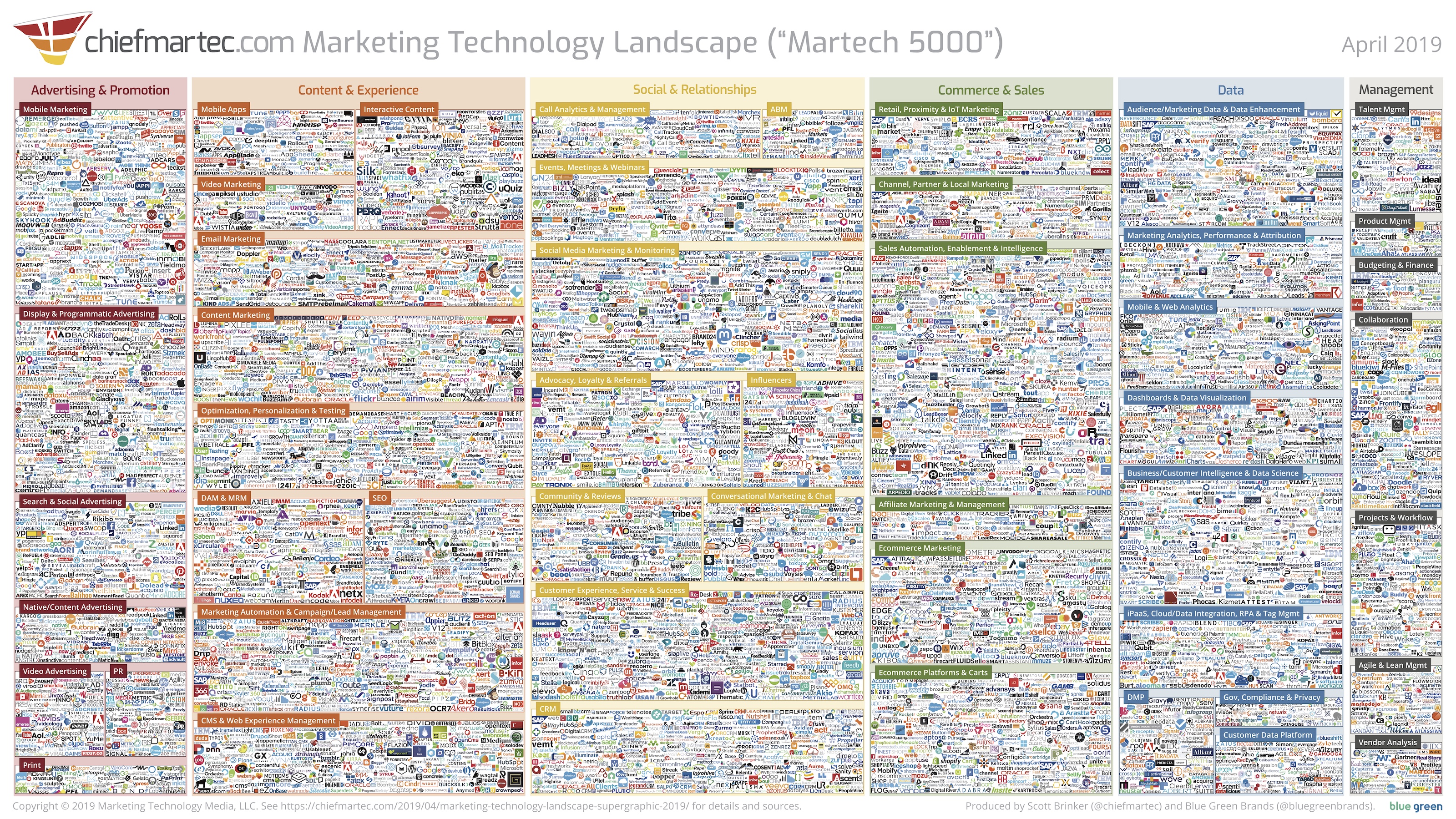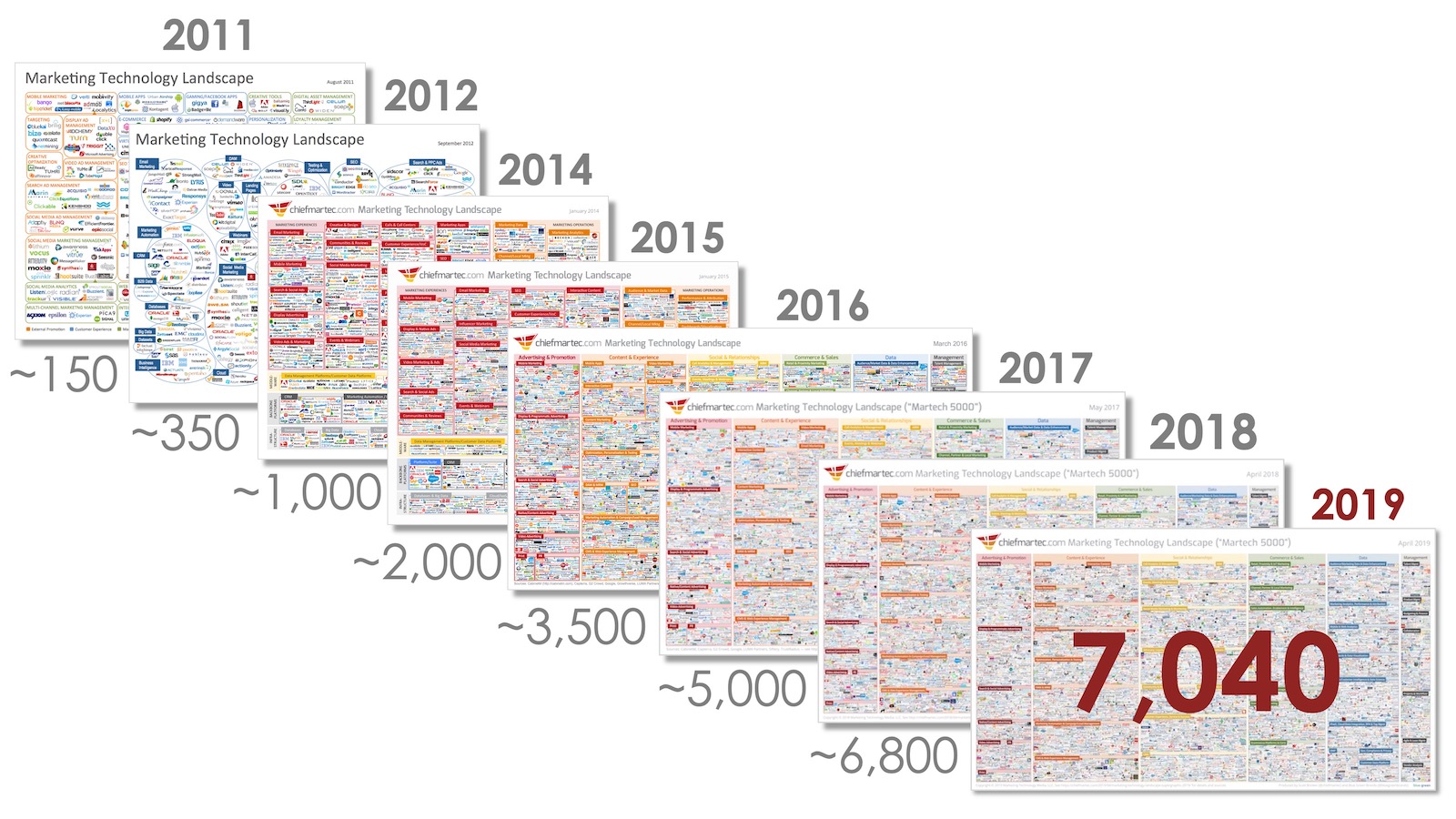When Scott Brinker first started compiling his now-famous martech lumascape, it was known as the “Martech 5000.”
These days, it would be more aptly dubbed the “Martech 7000 and growing.”
On April 4, Brinker released the latest edition for this year: The Marketing Technology Landscape 2019.

The growth of his supergraphic year-over-year has been a bit mind-boggling.
According to Brinker, the list of names in the space has doubled and sometimes even tripled each year since the first Martech 5000 compilation.
For example, the 2017 edition listed 37% more martech solutions than 2016. And 2018 named 27% more than 2017.

However, in 2019, things seem to have slowed.
This newest list showed just a 3% increase in names added to the industry-standard sampling of the martech landscape.
So does that mean martech has reached a peak, no more growth from here?
There are now 7,040 solutions included in the supergraphic — quite a long way from where we started.
As Brinker points out in his accompanying post on this year’s landscape, the marketing technology industry is stretching more than ever– becoming global and increasingly “citizen-led.” And Brinker’s team simply don’t have the time or resources to keep up with all the lightning-fast evolution.
He writes,
“It turns out that this isn’t so much “peak martech” as it is “peak martech landscape.”
See, there is a limit to how much time is reasonable to invest in producing this graphic. One could argue that I should have hit that limit several editions ago. But this year, having 9 people working on it for 3-4 months was as much as even I could justify (or afford).
Yet we know there’s a ton more marketing technology solutions out there. Not hypothetically speaking. I can actually point you at hundreds to thousands of martech products that aren’t on this year’s marketing technology landscape.”
In other words, it’s becoming impossible — or at least unreasonable — to track how wide this space has become.
Brinker called out a number of interesting insights in his post, particularly trends on growth.
In the near future, we can expect martech to particularly continue growing in these areas.
1. Regional martech
As the popularity of Brinker’s supergraphic grows, countries all over the world, from Canada to Finland, China, and the U.K., have released their own versions.
The team compiling the U.S. version didn’t cross-reference before publishing, which means the “real” number of martech companies is likely much larger. And it likely includes lots of highly-specific solutions.
“Since I’ve been so impressed with these, I’m embarrassed to say that we didn’t think to cross-reference this when we were assembling our global landscape this year until after it was off to press. We missed hundreds of regional martech companies. And that’s just considering the handful from countries with a published landscape.”
2. Vertical industry martech apps
Remember when “there’s an app for that” was a catch-phrase-turned-joke?
Now, no matter what your industry or what solution you’re in need of for that industry, there’s probably, somewhere, an app for that.
And the Martech 7000 might not even list the half of it:
“Similarly, while we’ve certainly incorporated many vertical industry martech apps into our landscape, we know we’ve barely scratched the surface of what’s out there — companies like LabWorthy in the dental industry or ChurchCRM, neither of which are on our landscape. Just finding these companies, without going deep in every industry ourselves, is a Herculean task.”
Many platforms build apps specifically for their individual ecosystems, making those micro-solutions nearly impossible to keep tabs on.
For example, WordPress has 54,000 plugins designed specifically for the platform. And each one could be called a kind of “mini martech app.”
It would be impossible to keep track of all those micro-solutions. But the fact that there are so many out there is indicative of the kind of personalized offerings that are becoming increasingly commonplace.
3. Citizen martech
This leads us to the final martech growth trend, which was especially unlikely to have been fully captured in the increasingly overwhelming supergraphic.
We can anticipate the rise of highly-specific martech solutions, built by people who aren’t necessarily tech savvy.
Brinker mentions the example of Airtable, which “makes creating a martech app as easy as creating a spreadsheet.”
Many people might say these aren’t “real” martech apps because they’re often only for use within a single organization. But Brinker posits that these self-serve martech solutions could very well be where the industry is headed:
“This democratization of development in marketing technology dramatically expands the number of people who can create martech apps. As a result, a lot more martech apps are produced — even if they’re relatively small and serve a highly specialized function.”

Are you ready for a Martech 50,000?
While Brinker says that there’s really no way to know how many solutions aren’t included on the list, he puts the number as high as 50k.
In an industry that’s rapidly changing, it can be tempting to quibble with what counts as an “app” and which solutions are “actually martech.”
Yet the list keeps growing, to the point where solutions are so deeply ingrained in platforms and organizations that we can’t really keep track of them.
And to Brinker, this presents proof that we have probably not reached “peak” martech.

We’re most likely only beginning to understand the ways in which martech will continue to grow and shape the future.












